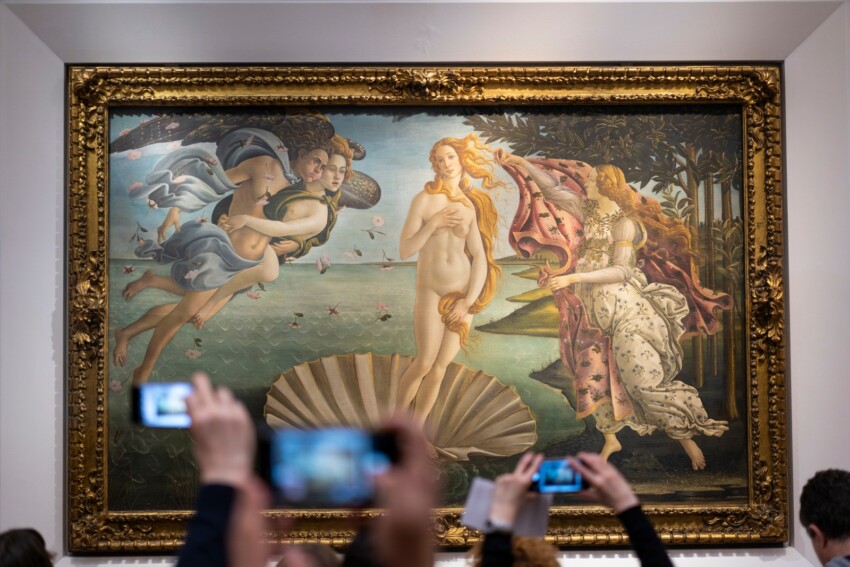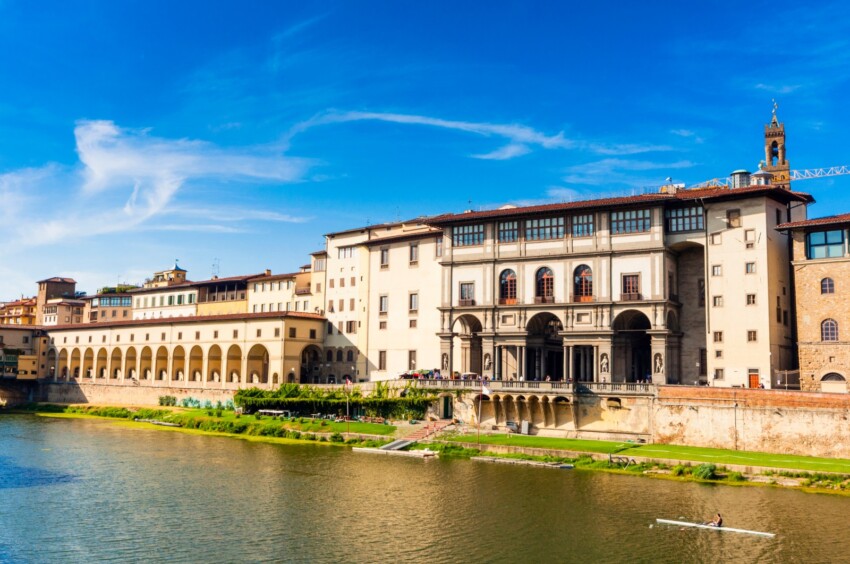
The Uffizi Gallery is the most visited museum in Italy, and one of the most important art museums in the world. Located in the historical centre of Florence, in the Uffizi square behind Palazzo Vecchio, it houses the world’s largest collection of works by Raphael and Botticelli, as well as numerous works by the likes of Giotto, Titian, Leonardo da Vinci, Pontormo and Bronzino.
Basically, the historical core of the Uffizi’s works comes from the private collection of the Medici family, which has been enriched over the centuries mainly through donations by private individuals or institutions. Today, the Uffizi houses the largest and most important Florentine Renaissance collection in the world. Visiting this incredible museum during a holiday in Florence is an absolute must, not only for art experts but also for ordinary people, who will find themselves immersed in so much beauty as to be almost unimaginable.
The Uffizi Gallery is home to some of the world’s most important paintings, seen again and again in books, magazines and posters. The most famous of these are undoubtedly Botticelli’s Venus, Botticelli’s Primavera ,Leonardo da Vinci’s Annunciation, Michelangelo’s Tondo Doni, and Caravaggio‘s Shield with the Head of Medusa.
Today, the term ‘The Uffizi Galleries’ refers to a museum complex that includes, in addition to the Uffizi, the Vasari Corridor, Palazzo Pitti and the Boboli Gardens.

The Uffizi collections are divided into four themes: painting, architecture, sculpture and the cabinet of drawings and prints. The exhibition route is divided into a series of corridors, which form a guided tour through the two floors of the building. The rooms follow a chronological order, and some of them are dedicated to the main Renaissance artists.
Of these, here are the most important ones, the ones not to be missed if time is short.
The Botticelli Room actually occupies rooms 10 to 14 of the exhibition route. The world’s largest collection of Sandro Botticelli‘s work is on display here, and you can admire his two most famous masterpieces: the Primavera and the Birth of Venus.
They are complemented by other works of incredible scope and importance, including the Madonna of the Magnificat, the Portrait of a Man with Medal of Cosimo the Elder, the Madonna of the Pomegranate and the Coronation of the Virgin.
In Room 15 of the Uffizi there is a section dedicated to Leonardo da Vinci‘s artistic beginnings. On display here is his first documented work, the Baptism of Christ. The Annunciation, which was painted when Leonardo had just passed the age of 20, is noteworthy, but the Adoration of the Magi, an unfinished work painted in oil on panel and tempera grassa, is also worth a closer look.
Observing the Tribuna degli Uffizi, a small octagonal room, you will surely be amazed. It represents the original nucleus of the Uffizi, for many the first museum in the West, and its bright red walls filled with paintings are truly unforgettable.
The objects and decorations in the room are inspired by the four elements of air, water, earth and fire, there are many paintings hanging on the walls, and a beautiful table inlaid with semi-precious stones frames a series of antique statues of the Medici, placed in a circle.
During the 2010-2012 renovation, the floor of the Tribuna was uncovered: this prevented direct access, and today it can only be visited by looking out of the entrance doors.
This exciting corridor, offering unique views of the Arno, Ponte Vecchio and Piazzale Michelangelo, showcases ancient statues, also enhanced by excellent lighting as it faces entirely south. On the ceiling, one can admire some frescoes with a religious theme, commissioned by Grand Duke Cosimo III.
The statues include Cupid and Psyche, Alexander dying, Olympia, Phidias’ Seated Venus, the Dancing Satyr and the Seated Maiden Ready to Dance. Many of these statues date back to the last centuries before the birth of Christ.
Ten rooms of the Uffizi Gallery, numbered 25 to 34, are dedicated to the 16th century. Among the most representative art masterpieces are Michelangelo’s Tondo Doni, Titian’s Venus of Urbino and Parmigianino’s Madonna with the Long Neck.
The rooms of the 16th century are organised by region: the first are dedicated to the Florentine painters, followed by the Venetian, Emilian, Veneto and Lombard schools.
Between 2010 and 2012, the Uffizi was expanded with a series of new rooms.
The blue rooms number 10, numbered 46 to 55, and display works by foreign painters from the 17th and 18th centuries, including the Spanish Velazquez, Goya and Ribera, the French Le Brun and Vouet, the Dutch Rembrandt and numerous other compatriots from the schools of the southern Netherlands.
The red rooms, on the other hand, are 9 in number, and showcase works of Florentine Mannerism alongside some masterpieces of ancient art, as if to create a parallel. There are some monochromes by Andrea del Sarto, works by the likes of Bronzino, Rosso Fiorentino and Pontorno, and an entire room, number 66, dedicated to Raphael.
In 1993, a series of rooms in the Uffizi Gallery were dedicated to Caravaggio. The famous painter does not have many works, but those present are incredibly representative of his early creative phase, that of his youth. Noteworthy is the Bacchus and the very famous Head of Medusa, painted on a wooden shield.
Tickets for the Uffizi can be purchased directly from the ticket offices or online; the latter is the recommended option to avoid queues and maximise your time. With the museum ticket you also have access to the National Archaeological Museum and the Museum of the Opificio delle pietre dure. The ticket is free of charge for the disabled under 18 years of age and a number of categories, while 18-25 year olds are entitled to reduced admission.
It is also possible to purchase a ticket valid for 5 days called Passepartout 5 Days, which includes entrance to Palazzo Pitti, the Boboli Gardens and the museum of the Opificio delle pietre dure, with priority access. To take advantage of this ticket, the Uffizi must be the first museum to be visited for the ticket to be activated, entering through door 3, while Palazzo Pitti and the Boboli Gardens must be visited within 72 hours of activation.
For enthusiasts or residents, it is possible to purchase an annual ticket, valid 365 days from a chosen date. This ticket includes access to all temporary exhibitions, and priority access except for free days. It is also possible to purchase a Family version, valid for 2 adults and an unlimited number of children.
The Uffizi is open from Tuesday to Sunday from 8.15am to 6.50pm, with last admission at 5.30pm; on Saturdays, Sundays and public holidays reservations must be made at least one day in advance. The museum is closed on Mondays, and on Christmas and New Year’s Day.
There are no guided tours organised directly by the museum, but it is certainly possible to take private or group tours with the knowledgeable Florence tour guides. If you don’t know them personally, look for the one that inspires you the most by relying on the internet, and choose it on the basis of the proposed programme, prices and user reviews.

Our first tip for visiting the Uffizi Gallery is to buy your tickets in advance. The queue can get really long, and despite being in the shadow of the elegant loggia, the wait is still exhausting, especially thinking about the amount of time wasted.
As one of the most popular museums in Europe, the Uffizi is always very crowded. If you can, visit them outside the peak tourist flows, perhaps taking advantage of the low season.
A visit to the Uffizi Gallery can even take a whole day. Consider carefully the time you have available to visit Florence, devoting more or less time to exploring the individual rooms.
The Uffizi can be a perfect break from Florence’s scorching summer heat, but also an ideal alternative for rainy days. Unfortunately, however, you will not be the only one to think so: be prepared for crowds inside the individual rooms.
There is a free cloakroom inside the Uffizi; umbrellas, large backpacks and bags must be deposited here. There is also a second cloakroom, reserved for groups and bulky objects, located at the ticket office in the Loggiato di Ponente.
The museum has a cafeteria with a panoramic terrace located on the second floor; the perfect stop to relax with an extraordinary view of Palazzo Vecchio.
On the ground floor of the Uffizi, near the exit, is a post office, which also offers the museum’s postal cancellation and philately services, as well as a currency exchange counter.
There are two special routes for people with disabilities, part of the project called Uffizi for All.
The first is dedicated to deaf people and is called “Masterpieces in sign language” : it presents video descriptions of the most important works of the Uffizi such as the Primavera by Sandro Botticelli, the Portraits of the Dukes of Urbino by Piero della Francesca and others, with explanations and essential information.
The second special route is dedicated to the visually impaired. It is called “Uffizi da toccare” (“Uffizi to touch”) and allows visitors to touch some of the original sculptures that belonged to the Medici collection on their own; in addition, there are numerous Braille captions and appropriate signage along the route.

The Uffizi Gallery is easily reached on foot, as it is located in the historic centre, a stone’s throw from Piazza della Signoria and Ponte Vecchio. From Santa Maria Novella station the walk takes about 15-20 minutes, unless you stop in Piazza del Duomo (which you will cross on the way) or in one of the shops on Via Calzaiuoli.
It is not possible to get to the Uffizi by car, unless you enter the car-free zone behind them, which passes through Piazza San Firenze and Via del Proconsolo. By public transport, on the other hand, you can get there via the local public transport line C1, which leads from the Santa Maria Novella station about 200 metres from the entrance to the Uffizi.
An alternative way to get very close to the Uffizi by car is to cross the Arno on the San Niccolò bridge, which is open to vehicular traffic since it is outside the car-free zone, and follow the course of the river back towards the historical centre, passing along the Lungarno Cellini, Lungarno Serristori, Lungarno Torrigiani and Via dè Bardi. You will pass through the car-free zone cameras, but don’t worry: if you park in the private garages in the area, they will take care of ‘cancelling’ your passage through the telematic gates, thus avoiding the fine. At this point you will be right on the other side of Ponte Vecchio: cross it and you will be practically behind the Uffizi loggia.
The Uffizi Gallery is located in the historical centre of Florence, in the immediate vicinity of Piazza della Signoria. The lower side overlooks the Arno, a short distance from the Ponte Vecchio.